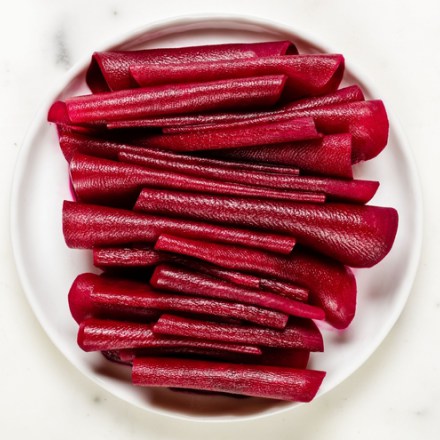Ingredients
| 450 g | red beets (2 large beets), rinsed and peeled |
| 1125 g | water |
| 22.5 g | Diamond Crystal kosher salt |
| 1 pound red beets (2 large beets), rinsed and peeled |
| 5 cups water |
| 7½ teaspoons Diamond Crystal kosher salt |
Essential Equipment
Instructions
- 450 g red beets (2 large beets), rinsed and peeled
- 1125 g water
- 22.5 g Diamond Crystal kosher salt
- Let beets ferment for 7 days; check container daily, skimming residue from surface and pressing to keep beets submerged. After 7 days, taste beets daily until they have reached desired flavor. They should be sweet, sour, and crisp.
- Discard bag of brine and parchment and skim off any residue. Drain beets, reserving pickling liquid (kvass). Serve. (Leftover beets and kvass can be combined in clean airtight container and refrigerated for up to 1 month; once refrigerated, flavor of beets will continue to mature.)
Instructions
- 1 pound red beets (2 large beets), rinsed and peeled
- 5 cups water
- 7½ teaspoons Diamond Crystal kosher salt
- Let beets ferment for 7 days; check container daily, skimming residue from surface and pressing to keep beets submerged. After 7 days, taste beets daily until they have reached desired flavor. They should be sweet, sour, and crisp.
- Discard bag of brine and parchment and skim off any residue. Drain beets, reserving pickling liquid (kvass). Serve. (Leftover beets and kvass can be combined in clean airtight container and refrigerated for up to 1 month; once refrigerated, flavor of beets will continue to mature.)
